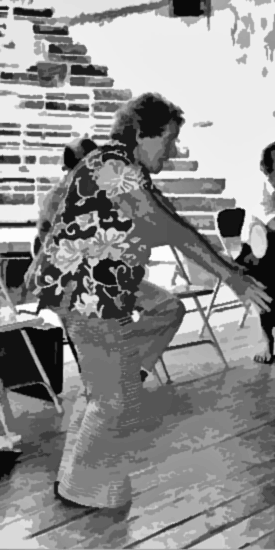Hilde Holger, in her eighties and nineties began writing her autobiography.
Below, are some quotes from Hilde Holger’s HISTORY PAGES.
“My pianist in 1956 was John Beckett, cousin of Samuel Beckett. He was not only a very good pianist but a very talented accompanist and a fine composer. We worked together on different items, including Rhythms of the East and Men and Horses. At that time modern dance in England was still very little known as great dancers like Mary Wigman and Harald Kreuzberg never came to England to perform, whereas they were famous all over the world. Solo performances, common on the continent, were unknown here. My dance group was invited to share a program at St Martin-in-the-Fields in which the only other performers were classical dancers. The audience consisted mainly of their friends with hardly any of ours. I said to my dancers Don’t be sad when the audience don’t applaud as our style of dance is not classical and so not understood. We danced two items: ‘Under the Sea’ by Saint-Saens and ‘Men and Horses’, music by John Beckett. To our great surprise the audience applauded very strongly and accepted our style of dance enthusiastically. At the end of the performance the Entertainment Officer for Enfield who happened to be in the audience engaged our group for a performance in one of Enfield’s largest colleges. …
In the sixties, we again performed in many churches. On the alter of Saint Philips, I choreographed “The Creation of Adam and Eve” with music by Messian. In the 1968 version, Royston Maldoom played Adam, and Verena Pottell played Eve. The same programme also included “Ballade of the Hanged” to a poem by Francis Villon with improvised music by Thomas McLelland-Young, which gave the eerie atmosphere to that sinister choreography. Lindsay Kemp spoke and danced. …
Less happy I felt when Darius, my son, came into school age and a lady doctor from the council came, looked at Darius and said to me ‘You can put him in an institution, you must not keep him at home’ and I said ‘I am his mother and brought him in this world and he will stay with me as long as I live.’ Darius turned out to be a lovable boy with a great sense of humour and also a great sense of music and dance. He was liked by everyone he met, and also showed me the way to teach mentally handicapped persons. I first tested my teaching on him and saw good results in his interest in movement and music. He opened to me new possibilities as to how movement and music can enrich the life of boys and girls with the same handicap. …
He attended first a club with a very progressive leader, a German, John Menzhausen of whom I asked if I could hold a class for all the boys. He willingly agreed and after the boys showed so much interest, I asked Dr Menzhausen if I could choreograph a work for them. He was at first very skeptical but then said: Go ahead. I called the work “Towards the Light” with music by Grieg. The idea that Towards the Light was to express is that handicapped people are to be accepted by those more fortunate in the community, sharing their lives and not to live a lonely life. I used one of my dancers called Carl Campbell to help to put the performance together and to guide them on the stage and it worked very well.
The work Towards the Light was performed at the Sadler’s Wells Theatre on 16 March 1968 and the public was enthusiastic. Several people came to me afterwards telling me how well these boys moved on stage and how expressive they were and I was so happy with this first experiment. Dr Menzhausen was touched to tears.
That was a beginning with a great future. The work was continued on a much larger scale by one of my talented pupils Wolfgang Stange who developed the idea of working with the blind and mentally handicapped. He has choreographed works that put students on stage in big performances and has achieved great results. Wolfgang has devoted his life in bringing light into darkness to all those boys and girls who beforehand were deprived of the happy experience of taking part in such creative performances.
1979 saw the great exhibition in Vienna, Dance of the 20th Century, arranged by the Vienna Theatre Museum. I was invited to contribute items from my work in Vienna, India and England. I was very glad that a prominent place was given to my great teacher Gertrud Bodenwieser and her pupils to whom I gladly belong. Bodenwieser’s work from Vienna and Australia was shown. I was asked to make a film about my work, which was funded by the British Arts Council. …
In 1983 I got an invitation form one of my former pupils in India, Jer Jessawalla to spend a holiday at her lovely house at the beach of Juhu. I was very happy to accept her kind invitation and met old pupils and old friends whom I’d not seen since I left India. After thirty three years I came back to my beloved India. Many things have changed. …”
© Primavera Boman-Behram 2001

